The World of Gerry and Sylvia Anderson
by Mike Clark and Marc Wielage
Rocket's Blast Comicollector {RBCC} No 119 (June 1975) p2, p6-12;
reprinted in Trek Number 4 (March 1976); p4-12
reprinted in Trek Special Number 2 (Nov 1978); p24-31. Thanks to Paul Stankevitch.
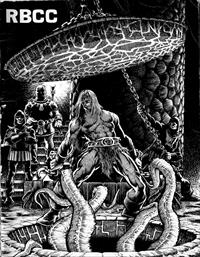
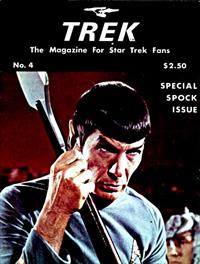
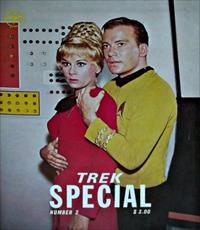
This article appeared in 3 different fanzines, beginning with Rocket's Blast Comicollector, with almost the same pictures and layout in Trek ("The magazine for Star Trek fans") which featured a colour cover and glossy pages, and finally in the reprint "Trek Special".
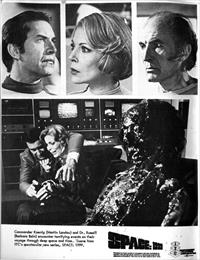
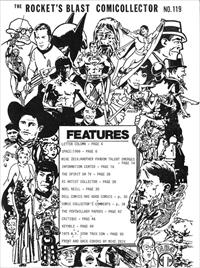
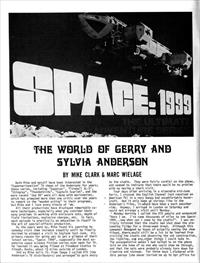
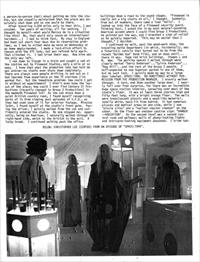
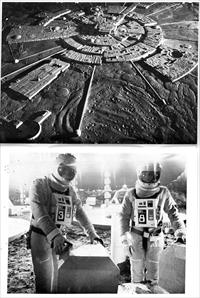
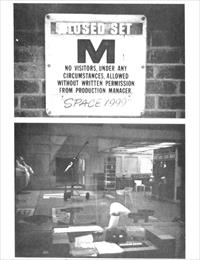
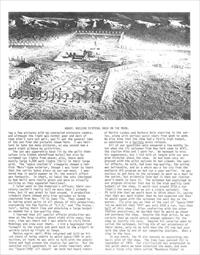
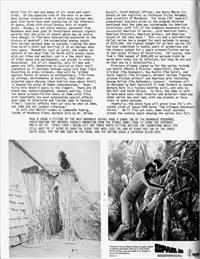
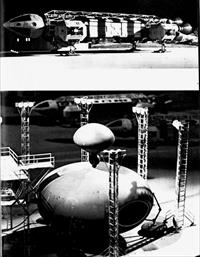
Both Mike and myself have been interested in the "Supermarionation" TV shows of the Andersons for years; these series, including Supercar, Fireball XL-5, Stingray, Thunderbirds, Captain Scarlet, and the more recent Joe 90 were all done with marionettes, which has prompted more than one critic over the years to remark on the "wooden acting" in their programs, but Mike and I love every minute of 'em.
All their productions have displayed remarkable camera techniques, especially when you consider their many problems in working with miniature sets, depth of field limitations, explosive charges, etc. In fact, each episode is practically an education in itself in the art of special-effects production.
As the years went by, Mike found his yearning to someday visit them increase steadily until he finally decided to attempt a visit to England last June. His primary reason for going was to get a glimpse of their latest series, Space: 1999, supposedly the most expensive space science fiction series ever made for TV. He learned it was being filmed at Pinewood Studios in Slough, Bucks, about 15 miles outside of London.
And as Mike tells it: From Tampa I called ATV (the Anderson's TV distributors) and arranged to gain entry to the studio. They were fairly cordial on the phone, and seemed to indicate that there would be no problem with my having a short visit.
Four days after arriving in a miserable mid-June Paris, I crossed the English Channel (not received on American TV) in a very bumpy and uncomfortable hovercraft. Had it only been on strings like in the Anderson's films, it would have been a much smoother ride. Anyway, I arrived in London on Saturday and could not arrange a visit until Monday.
Monday morning I called the ATV people and announced "Here I am. I've come thousands of miles to see Space: 1999...now when can I come to the studio?". I was politely informed that the studio had shut down the preceding Friday for a three-week break. Although this somewhat dampened my hopes of actually seeing the show filmed, there would still be a lot to be learned from visiting the studio and observing the set construction, the lighting, and any other things I could take in. The uncooperative woman I had talked to on the phone told me she knew of no one who could show me through, and that the sets were probably already torn down for cleaning and storage. For three days I dickered with this person (she never invited me up to her office for a person-to-person chat) about getting me into the studio, but she steadily maintained that the place was absolutely shut down and no one would be there.
After travelling 3,000 miles only to hear this, I was crushed. Ten years of waiting, all for nothing. (I thought to myself--what would Marcus do in a situation like this? No, that would only cause an international incident...) I had to think fast. My stay in England had been cut short four days due to reservation problems, so I had to either make my move on Wednesday or go home empty-handed. I made a last-ditch effort to reason with the ATV lady, but was refused help again. That clinched it. I had tried their way. Now mine was the only way left.
I ran down to Slough in a train and caught a cab at the station out to Pinewood Studios, only a mile or so away. I knew that what the promotion lady had told me was untrue--no studio ever shuts down completely. There are always some people drifting in and out as I had learned from experience at the TV stations I've worked for. But the immediate problem: how could I get in without an appointment? I didn't even know the layout of the place; how could I ever find Century 21 Productions (recently changed to Group 3 Productions) in the mammoth Pinewood lot? As the cab drove down a quiet British country road, I found myself recognizing parts of it from viewing past episodes of U.F.O., as they had used some of it for exterior footage. Minutes later, I found myself at the studio's front gate. Paying the driver, I quickly walked from the cab and confidently entered the studio. No one stopped me; apparently, being an American, I naturally walked through the right-hand side, which to the British is the exit. A lucky break. I continued walking past the office buildings down a road to the sound stages. "Pinewood is really not a big studio at all," I thought.
Suddenly, from out of nowhere, there came a loud "Hello". I looked up into the face of a Pinewood security guard. Thinking fast, I asked him in my most natural-sounding American accent where I could find Group 3 Productions. He pointed out the way, and I breathed a sigh of relief as he quickly departed. "This may be easier than I thought," I decided.
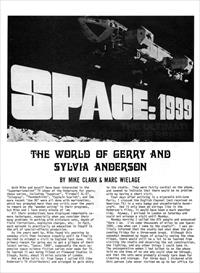
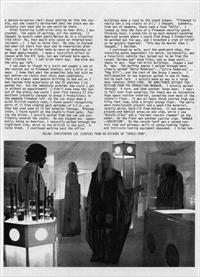
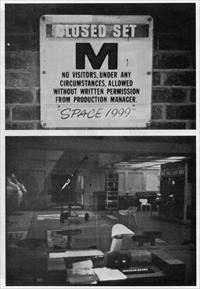
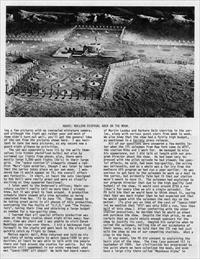
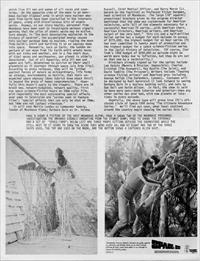
I continued my walk, past the wood-work shop, the travelling matte department (in which, incidentally, was a futuristic vehicle that turned out to be from the recent Golden Gun Bond film), and on down until... there it was. Huge red brick buildings. Stages L and M. Wow. The parking spaces I walked through were clearly marked "Gerry Anderson"..."Sylvia Anderson"... "Reg Hill"...and the rest of the Group 3 people. I half-expected to see Supercar parked in one of them, but no such luck. I quickly made my way to a large door labelled: SPACE:1999. NO ADMITTANCE WITHOUT PERMISSION FROM THE PRODUCTION MANAGER. I bravely walked through. A turn, and then another large door. I nearly fell over from surprise, for there was an incredible huge space station interior, sprawling over most of the studio's floor. It was at least three stories high and fifty feet long, with a bright orange floor [This is the Nuclear Generating Area set from Force Of Life, which was left up during the production break to be used in the next episode, Alpha Child]. The walls were translucent plastic and a wood-like material, totally white, back-lit from behind. It had numerous alcoves and medical areas on one side, while I saw "missile silos" and a "nuclear reactor chamber" on the other. On the floor was another caution sign: "DANGER--RADIATION". On the second level was a second control room and walkway; walls of phony-looking lights and intricate-looking equipment abounded. I tried taking a few pictures with my concealed miniature camera, and although the light was rather poor and most of them didn't turn out well, you'll get the general idea of the set from the pictures shown here. I was hesitant to take too many pictures, as any second now a guard might glimpse my activities.
The set was apparently base lit by the walls themselves (via hidden photoflood bulbs) but also by scrimmed cyc lights from above; also, there were mostly large 5,000 watt lights (5k's) in their large grid. The "space station's" viewports showed a red-dish "Mars"-type exterior, though I was later to learn that the series takes place on our own moon. I wondered how it would appear on TV; the overall effect was fantastic. In short, at least the sets (designed by Bob Bell [by Keith Wilson]) were really great and were as visually exciting as they appeared functional.
I later went to the Anderson's offices; their secretary couldn't really tell me more than I already knew, but it was great to look around. A production schedule there showed only nine episodes as being completed from Nov. '73 to June '74. They seemed to be taking great pains in all phases of this production, overcoming the few faults of U.F.O. and The Protectors, taking their time and obtaining a large budget as needed for a top-quality show.
I learned that all special effects production was done at the Bray studios about eight miles away; however, time was short and I was unable to visit Derek Meddings [Brian Johnson] and crew over there. I bid a hackneyed fond farewell to the studio and went back to the airport to quickly catch my flight to Tampa.
Marcus again: Well, Mike returned and told me his sad story of being unable to watch Space: 1999 in production; at least he was able to talk with the people there and look around the studios for awhile. But the question still uppermost in our minds remained: what was Space: 1999 all about? We both had heard rumours of Martin Landau and Barbara Bain starring in the series, along with various guest stars from week to week. We also knew that the show had a fairly high budget, as mentioned in a Variety press release.
All of our questions were answered a few months later when the ITC salesman from New York came to WTVT, the station Mike and I work for. We managed to miss his appearance, but I did talk at length with our program director about the show. He had been very impressed with the pilot episode he had viewed; the special effects, he said, had been top-quality, the acting was believable, and as a whole was a far cry from the mediocre UFO program we had run a year earlier. He was anxious to get back to the salesman to work up a deal to the series, but evidently fate had it that our station wasn't meant to have it. The salesman had explained to our program director that due to the high quality (and budget) of the show, it would cost around $750 a run (that's for every time we air a single episode). The PD told him that we would have to think about it, saying that that was much higher than he had expected and that he would speak with the salesman the next day on the matter. (To give you an idea of the cost of Space: 1999 let me mention that UFO was only $350 a run, less than half of this show.) After conferring with the other station executives, he decided that he would go ahead and purchase the show. Despite the high price, he was certain that we could obtain enough sponsors for the show to justify its cost. Imagine his surprise when he called the salesman, telling him of our acceptance of their terms, only to be told that the ITC rep had just sold the show to one of our competing stations. What a slap in the face. [The Tampa rival who bought the series was WFLA]
In any event, the PD did consent to explaining the basic plot of the show. The time (you guessed it) is September of 1999. Our civilization has progressed to the point where we have colonized the moon, and even have a large city there called "Moonbase Alpha" in which live 311 men and women of all races and countries. On the opposite side of the moon is an enormous nuclear disposal area in which many nuclear weapons from Earth have been stockpiled in the interests of peace, along with miscellaneous bits of atomic waste. Anyway, as our story begins, personnel from Moonbase have been sent to investigate ominous signals warning that the piles of atomic waste may be active. Sure enough, in the most devastating explosion in the history of mankind, the accumulated energy causes this nuclear garbage dump to explode, ripping the moon from Earth's orbit and hurtling it on an odyssey deep into space. Meanwhile, back on Earth, the sudden departure of our moon from its Earth orbit wreaks havoc with our tides and weather, and in a few short days of tidal waves and earthquakes, our planet is utterly devastated. Out of all humanity, only 311 men and women are left, determined to survive on their small planetoid as it journeys through space (ala Argo City). According to press releases, they will be "pitted against forces of nature so extraordinary, life forms so strange, environments so hostile, that their unexpected space odyssey (does Kubrick know about this?) is beyond the grasp of human comprehension." Hopefully this doesn't apply to the viewers. There are 24 brand new, network-budgeted, network quality, first run space science-fiction hours on 35m color film, with reportedly the most outstanding special effects ever seen in television and "seldom seen in feature films"; "special effects that can only be shot on 35m, not l6mm and not (pshaw) videotape."
It will star Martin Landau as Commander Koenig, leader of Moonbase Alpha; Barbara Bain as Dr. Helena Russell, Chief Medical Officer, and Barry Morse (Lt. Gerard on The Fugitive) as Professor Victor Bergman, head scientist of Moonbase. The large (18" square!) promotional brochure given to the program director mentioned that the show was custom-made for American television, with "all of the elements necessary for a successful American TV series...with American stars, American Directors, American writers, and American talent of the very best.' This six and a half-million dollar series has a budget for each episode in excess of $275,000, the highest budget for an hour series ITC had ever committed in twenty years of production and the highest budget for a space science-fiction series in the (gulp) history of television. (Of course, Star Trek's 1966 budget of $200,000 an episode might be worth more today due to inflation, but they do win out on that one by a technicality.) [The Trek budget, adjusted for US inflation from 1966-1974, would have been $304,000]
Directors already signed up for the series include Lee Katzin (Mannix & Mission: Impossible), Charles Crichton (The Avengers), Ray Austin (The Saint), and David Tomblin (The Prisoner); Writers include "leading science fiction writers" and American pros including George Bellak (The Defenders, Cannon). Costumes will be designed by Rudi Gernreich (I look forward to seeing Barbara Bain in a topless bathing suit), and sets by Bob Bell and Keith Wilson [just Wilson]. In fact, the show is said to have more sets--both interior and exterior--than any other series has ever had, with new planets or locations in every episode. Hopefully, the above hype will prove true ITC's oft-stated claim of Space:1999 being "The Ultimate Adventure Series." We'll find out soon, when local stations around the country begin showing the series this fall.
Page 8 shows a picture of the vast Moonbase Alpha; page 9 shows two of the moonbase personnel investigating the ominous signals emanating from the atomic dump; page 10 shows the entrance and a set of Space: 1999; below left are three props sitting outside the soundstage while the still next to it seems to show the scene they were used in; and at right are two of the space ships used, the top one used on the moon, and the bottom shows a captured alien ship.
Thanks to Paul Stankevitch